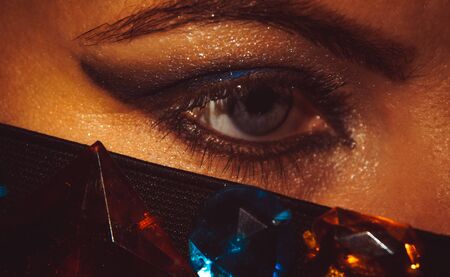Introduction to Under-Eye Concerns
The delicate area under the eyes is often one of the first places to show visible signs of aging and fatigue, making it a focal point in both personal care and aesthetic medicine. Common issues such as dark circles, puffiness, and volume loss are frequently cited concerns among Americans seeking to maintain a youthful and refreshed appearance. These concerns are influenced not only by genetics and lifestyle but also by environmental factors and aging processes that impact the skin’s structure. In American beauty standards, a bright, smooth under-eye area is associated with health, vitality, and overall attractiveness. As such, addressing these under-eye imperfections has become a significant part of many individuals skincare and cosmetic routines. Understanding the underlying causes of these issues is essential for selecting effective rejuvenation strategies, particularly with the growing popularity of minimally invasive treatments such as hyaluronic acid fillers.
2. What is Hyaluronic Acid?
Hyaluronic acid (HA) is a naturally occurring polysaccharide found extensively in human connective tissues, skin, and eyes. Its molecular structure consists of repeating disaccharide units composed of glucuronic acid and N-acetylglucosamine. This unique configuration allows HA to bind up to 1,000 times its weight in water, giving it exceptional hydrating properties. In the context of under-eye rejuvenation, these characteristics make hyaluronic acid an ideal candidate for dermal fillers, particularly when compared to other filler materials like collagen or synthetic polymers.
Molecular Properties
The viscoelastic nature of hyaluronic acid allows it to integrate smoothly into the delicate periorbital tissue. The molecules high biocompatibility significantly reduces the risk of adverse reactions or immune responses, which is crucial for sensitive areas such as under the eyes. Furthermore, HA is biodegradable and can be broken down by natural enzymes in the body (primarily hyaluronidase), ensuring that results are temporary but reversible if needed.
Comparison with Other Dermal Fillers
| Property | Hyaluronic Acid | Collagen | Synthetic Polymers |
|---|---|---|---|
| Source | Natural (human/animal/bacterial fermentation) | Animal-derived (bovine/human) | Chemically synthesized |
| Hydration Capacity | Very high | Moderate | Low to moderate |
| Biodegradability | Yes (enzymatic) | Yes (enzymatic) | No/Partial |
| Immunogenicity | Low | Moderate to high | Variable |
| Reversibility | Yes (with hyaluronidase) | No specific reversal agent | No specific reversal agent |
Why Hyaluronic Acid is Favored in Under-Eye Treatments
The safety profile, hydration effect, and reversibility of hyaluronic acid make it the leading choice for treating tear trough deformities and hollows under the eyes. Unlike other fillers that may cause more swelling, allergic reactions, or unnatural texture, HA provides a smooth, natural appearance while minimizing downtime and risk—critical factors for individuals seeking subtle yet effective facial rejuvenation in a clinical setting.

3. Mechanism of Action in Rejuvenation
Hyaluronic acid (HA) is a naturally occurring glycosaminoglycan found throughout connective, epithelial, and neural tissues in the human body. When it comes to under-eye rejuvenation, HA plays a pivotal role at both the cellular and tissue levels. Its unique biophysical properties allow it to attract and retain water molecules, which directly contributes to enhanced tissue hydration and volume restoration in the periorbital region.
At the cellular level, HA acts as a critical component of the extracellular matrix (ECM), providing structural support for dermal fibroblasts and facilitating cell proliferation and migration. By maintaining optimal moisture balance within the skin, HA supports collagen synthesis and helps preserve skin elasticity—two essential factors that counteract thinning and sagging commonly seen under the eyes due to aging or environmental stressors.
On a tissue level, HA-based fillers are injected into targeted areas beneath the eyes to address volume loss, which often manifests as dark circles or hollows. The viscoelastic nature of cross-linked HA allows for precise contouring and integration with surrounding tissues, leading to natural-looking results without excessive swelling or lumpiness. Additionally, HA’s hydrophilic characteristics mean that even small amounts can significantly improve tissue turgor and smooth out fine lines by drawing in moisture from adjacent layers.
Furthermore, HA has been shown to modulate inflammatory responses and promote angiogenesis—processes that contribute to overall skin health and recovery post-injection. This combination of mechanical lift, hydration enhancement, and biological activity makes hyaluronic acid a cornerstone ingredient in modern under-eye rejuvenation therapies tailored for American patients seeking minimally invasive yet effective solutions.
4. Popular Under-Eye Treatments Using Hyaluronic Acid
In the United States, hyaluronic acid (HA) has become a cornerstone in non-surgical under-eye rejuvenation, primarily due to its proven safety profile and effectiveness. A variety of FDA-approved HA fillers are available for addressing volume loss and hollowness in the tear trough area. This section examines popular HA-based products, typical injection methods utilized by U.S. practitioners, and what American patients should anticipate during their treatment journey.
FDA-Approved Hyaluronic Acid Products for Under-Eye Use
| Brand Name | Main HA Product Line | Key Features | FDA Status for Tear Troughs |
|---|---|---|---|
| Restylane-L | Restylane | Smooth gel; suitable for delicate under-eye tissue; moderate swelling risk | Off-label, widely used by experts |
| Belotero Balance | Belotero | Soft consistency; integrates well into superficial dermis; reduces risk of lumps | Off-label, commonly used for fine lines and under-eyes |
| Juvéderm Volbella XC | Juvéderm | Low viscosity; minimal water absorption; reduces puffiness risk | Off-label but gaining popularity among specialists |
| Teosyal Redensity II* | Teosyal | Specifically designed for tear troughs; contains amino acids and antioxidants | *Not FDA-approved in the U.S., but mentioned for context |
*Note: In the U.S., all under-eye HA filler use is considered off-label, though these products have FDA approval for facial wrinkles or lips. Always consult a board-certified provider who specializes in periorbital injections.
Typical Injection Techniques in U.S. Practice
- Cannula Technique: Many American injectors prefer blunt-tip microcannulas over sharp needles to minimize bruising and reduce trauma. The cannula is typically inserted at the lateral cheek and guided beneath the orbital rim to deposit small amounts of HA filler along the tear trough.
- Puncture with Needle: For precise placement, some providers use a fine-gauge needle for direct injections into the pre-periosteal plane just below the orbital rim. This method may offer more control but can increase swelling or bruising risk if not performed skillfully.
- Aspiration and Slow Injection: Safety protocols emphasize aspiration before injecting to avoid intravascular placement and advocate slow injection rates to prevent complications such as Tyndall effect or vascular occlusion.
What Patients Can Expect from Treatment Sessions in the U.S.
- Treatment Duration: A typical session lasts 30–45 minutes, including consultation, topical numbing, and post-procedure care instructions.
- Pain Management: Most FDA-approved HA fillers contain lidocaine for comfort; additional topical anesthetic is often applied.
- Downtime: Patients usually experience mild swelling or bruising that resolves within 1–2 weeks. Ice packs and arnica are frequently recommended post-treatment.
- Results Timeline: Improvements are visible immediately, with optimal results apparent after swelling subsides (about 1–2 weeks).
- Lifespan of Results: Most HA fillers last 9–12 months under the eyes, although longevity varies by product and individual metabolism.
- Follow-Up Care: Providers typically schedule a follow-up visit within two weeks to assess symmetry and address any touch-up needs.
This evidence-based approach to under-eye rejuvenation reflects both advancements in HA technology and evolving patient expectations across the U.S. aesthetic landscape. By choosing FDA-approved products and qualified injectors, patients can maximize safety while achieving subtle yet significant improvements in periorbital appearance.
5. Safety, Risks, and Side Effects
When considering hyaluronic acid (HA) fillers for under-eye rejuvenation in the United States, patient safety and risk management are paramount. HA-based dermal fillers are FDA-approved for cosmetic use and generally regarded as safe when administered by qualified professionals. However, the delicate anatomy of the periorbital region introduces unique challenges that demand a high standard of clinical practice.
Best Practices in American Clinical Settings
To minimize risks, American practitioners adhere to evidence-based protocols including comprehensive patient assessment, proper product selection, and precise injection techniques. Pre-procedure evaluation involves identifying contraindications such as active infections, allergies to filler components, or underlying medical conditions. Using HA products with optimal viscosity and minimal hydrophilic properties reduces the risk of swelling and Tyndall effect—a bluish discoloration caused by superficial filler placement.
Potential Complications
Although rare, complications can occur. Common side effects include transient swelling, bruising, and mild discomfort at the injection site. More serious but infrequent risks involve vascular occlusion, persistent edema, irregular contouring, and migration of the filler material. In the U.S., practitioners are trained to recognize early signs of complications and intervene promptly—often with hyaluronidase enzyme injections to dissolve misplaced or excessive HA.
Risk Mitigation Strategies
Mitigating adverse outcomes requires strict adherence to aseptic technique, utilization of blunt-tipped cannulas rather than sharp needles when appropriate, and avoiding high-risk anatomical zones such as directly over blood vessels. Patient education is also critical; clear communication regarding realistic expectations, aftercare instructions, and signs of complications fosters a safer experience. Ultimately, choosing an experienced provider—preferably board-certified in dermatology or plastic surgery—is essential for reducing risks associated with under-eye hyaluronic acid applications in American clinical environments.
6. Patient Experience and Cultural Perceptions
In the United States, the pursuit of a youthful appearance is deeply intertwined with cultural values and social dynamics. Patients seeking under-eye rejuvenation with hyaluronic acid fillers often report high levels of satisfaction, primarily due to the minimally invasive nature and immediate results of the procedure. The psychological impact is significant—many individuals experience enhanced self-esteem and confidence following treatment, which can translate into improved social interactions and professional opportunities.
Hyaluronic acid’s role in restoring volume and reducing dark circles or hollows resonates with American ideals of vitality and wellness. Patient feedback frequently highlights not only the aesthetic improvements but also the natural look that well-performed treatments provide, aligning with the U.S. preference for subtle enhancements over dramatic changes.
Cultural Relevance of Youthful Appearance
Within the American context, a youthful appearance is often associated with energy, capability, and competitiveness. Media representations and workplace expectations reinforce these associations, making non-surgical cosmetic procedures more socially acceptable across diverse age groups and professions. Hyaluronic acid-based under-eye rejuvenation fits seamlessly into this landscape by offering effective solutions without extensive downtime or stigma.
Patient Satisfaction Metrics
Surveys and clinical studies consistently show high satisfaction rates among patients who undergo under-eye filler treatments in the U.S. Most respondents cite minimal discomfort, rapid recovery, and visible improvement as key benefits. Importantly, patient-centered approaches—including thorough consultations and individualized treatment plans—contribute significantly to positive experiences.
Addressing Psychological Well-being
The psychological benefits extend beyond surface-level aesthetics. Many patients report decreased feelings of fatigue or sadness related to their appearance after treatment, underscoring the strong mind-body connection in cosmetic dermatology. As societal norms continue to evolve, the demand for safe, effective under-eye rejuvenation options like hyaluronic acid is expected to grow, reflecting both personal aspirations and broader cultural trends.

